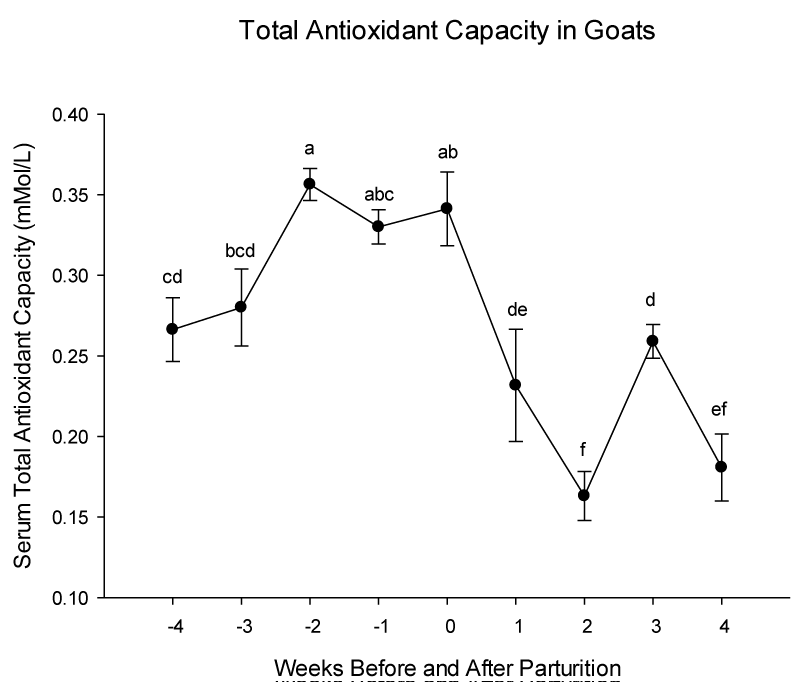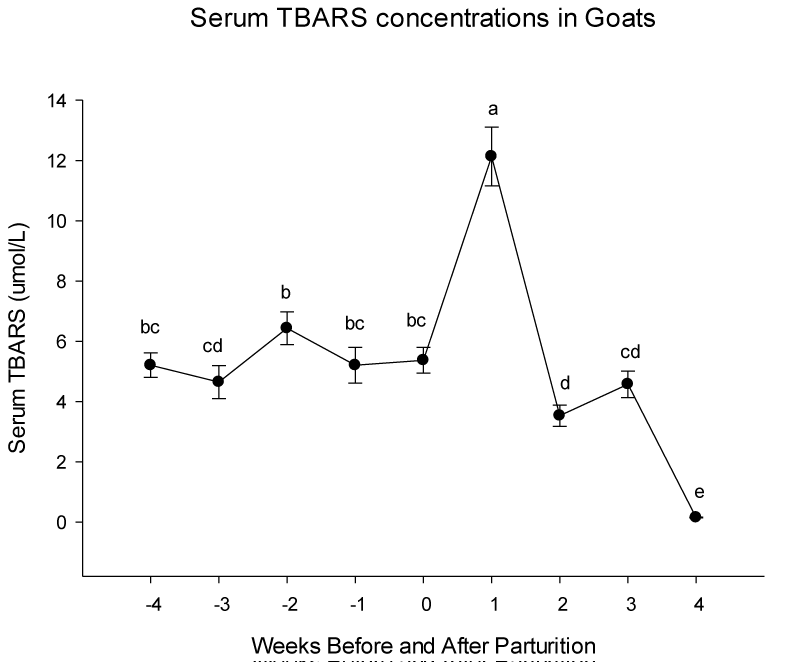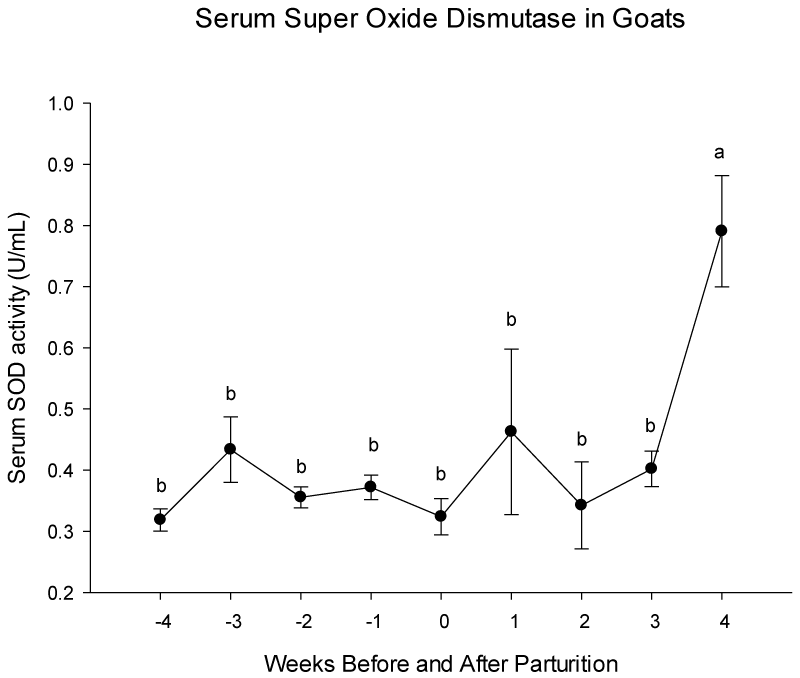International Journal of Veterinary Science and Research
The Influence of Pregnancy and Lactation on Plasma Antioxidant Status in Aardi Goats
Al-Hassan MJ1, HE Mohamed2*, Al-Samawi KA3 and Al-Badawi MA1
2Department of Basic Medical Science, Faculty of Applied Medical Sciences; University of Al Baha, Saudi Arabia
3Department of Animal Production, Faculty of Agricultural Sciences and Veterinary Medicine, Thamar University, Republic of Yemen
Cite this as
Al-Hassan MJ, Mohamed HE, Al-Samawi KA, Al-Badawi MA (2016) The Influence of Pregnancy and Lactation on Plasma Antioxidant Status in Aardi Goats. Int J Vet Sci Res 2(1): 032-035. DOI: 10.17352/ijvsr.000012The aim of this study is to assess the effects of pregnancy and lactation on selected antioxidant profile in Aardi, goats. Blood samples were taken from sixteen goats approached 3-4 months of pregnancy, and a month before parturition, blood samples were taken, and weekly until parturition, and then every week until four weeks postpartum. The total antioxidant concentrations increased during the 4th to the 2nd week before parturition, and started to decline until partition, and continued the decline until the second week after parturition, then increased again. Serum Thiobaributric Reactive Substances (TBARS) concentrations follow similar pattern to Total Antioxidant Concentration (TAC). Immediately after parturition, there was an increase in TBARS, and then by the end of 1st week started to decrease until the 4th week postpartum. Low serum Super Oxide Dismutase (SOD) four weeks postpartum, might be related to the lower activity of reactive oxygen metabolites, as indicated by the increased antioxidant capacity. Superoxide dismutase increased on the 2nd week postpartum up to the 4th week postpartum. In conclusion, this data about local goats will be beneficial for understanding the basic adaptive physiological biomarker.
Introduction
Antioxidants are chemicals inhibiting the oxidations of other chemicals and regulating the metabolic activity of ruminant. Pregnancy and lactation poses a challenge to goat industry, and also resulted in the generation of free radicals, causing damage to cell [1]. Better nutrition during late gestation may be improved in arid and semiarid regions around the globe [2]. According to Radin et al. (2015) [3], goats of higher parity display higher levels of metabolism intensity and consequently, varying levels of oxidative stress during the peripartum period. Basic physiological and biochemical profile for local Saudi goats are lacking. Studies on local breeds of goat in Saudi Arabia is lacking, in particular that of adaptational physiological to their harsh environment. Pregnancy and lactation poses a challenge to goat industry. The main aim of this study was to assess the effects of pregnancy and lactation on selected antioxidant biomarkers in local Saudi goats, Aardi.
Materials and Methods
Three Pens at the Department of Animal Production Research Station were prepared for receiving 16 female Aardi goats, in addition to 2 males Aardi. The 16 females were nulliparous and about 1.5 years of age. Animals were provided with feed (Alfa Alfa, and concentrate) according to NRC calculations, with water ad libitum. During the first month of the acclimatization period, males were tested for semen quality; semen was collected from the 2 males using electro ejaculator, and semen was examined under microscope for sperm motility, activity, and quality. Female Aardi goats were watch for heat (estrus) signs and by the end of the month, all females were ready for the experiment to start. Females were synchronized using a program called Ovsynch that includes using GnRH injection, followed by PGF2α 7 days after. Two days later, a second GnRH injection is given to the female Aardi goats, and introduced to the males. Female Aardi goats exhibited signs of heat by bellowing and accepting the approach of males. Dates of the first signs of estrus and mating were recorded in order to estimate the time of parturition.
Blood samples were collected into vacutainer tubes at the time of the second PGF2α injection in order to verify that serum Progesterone hormone concentration is low and serum Estrogen hormone concentration is high, which goes well with females that are in estrus. Blood samples were collected and centrifuged at 4 Co for 30 min. at 3000 rpm and stored at -200C until analysis. All samples were analyzed for the parameters indicated using ELISA kits bought from Cayman Pharma (USA).
Blood samples were taken from pregnant goats during the last month of pregnancy on a weekly basis. In addition, Blood samples were taken at the time of parturition, and for one month after that on a weekly basis. Total Antioxidant Capacity, TBARS, and SOD activities were measured in the plasma. Changes in the concentrations of TAS, MDA, and SOD were analyzed by means of ANOVA repeated-measures procedure. Data were expressed as the mean ± SE for all parameters. Fisher’s least significant difference (LSD) was used at a level of P< 0.05. All data were analyzed using SAS program (SAS Inst. Inc., Cary, NC).
Results and Discussion
Pregnancy and lactation are considered very demanding and stressful physiological stages in ruminants. Pregnancy is associated with oxidative stress in water buffaloes [4] and sheep and goats [5]. The main aim of this study was to assess the degree of oxidative stress in pregnant and lactating Aardi goats, local Saudi breeds, for the first time. Research on oxidative stress in the field of animal science is emerging as a new field of research.
Goats of higher parity displays varying levels of oxidative stress during the peri-partum period [3]. Stress imposed by pregnancy and lactation affected the reproductive performance in postpartum anestrous animals which might be inherently more susceptible to these stressors than those who were normal cyclic as all the animals were maintained under similar feeding and management practices [6].
Total antioxidant concentrations increased during the 4th to the 2nd week before parturition, and started to decline until partition, and continued the decline until the second week after parturition, then increased again (Figure 1). Previous studies outlined that the reproductive cycle (pregnancy and lactation) play role in antioxidant-oxidant balance in animal’s body. For example, dairy cows seemed to have more oxidative stress and low antioxidant defense during early lactation or just after parturition than advanced pregnant cows [7]. Oxidative stress and lipid peroxidation are involved in the development and complications of pregnancy toxemia [8].
Comparing first and second lactation, TAC and the parameters of lipid and protein peroxidation in blood showed increasing tendency in second as first lactation. The content of anti-oxidative vitamins and SH groups in colostrum/milk showed increasing tendency in second as first lactation, while TAC and content of end products of lipid peroxidation showed opposite trend [9].
Porcine levels of vitamin C and glutathione decrease during the peri-parturient period, which may lead to a decreased antioxidant defense system and an imbalance in redox homeostasis [10]. Decreased CAT activities after the 1st month of pregnancy were observed in ewes [11].
Figure 2 shows serum TBARS concentrations in goats. Serum TBARS concentrations follow similar pattern when compared to TAC. Immediately after parturition, there was an increase in TBARS, and then by the end of 1st week, TBARS concentrations started to decrease until the 4th week postpartum. Goats experienced moderate oxidative stress during the peripartum period [12]. Rapid modification of diet composition affects metabolic and oxidative homeostasis in lactating sheep [13]. The combination of MDA and TAS can provide complementary information about the metabolic status of the cow [14].
The antioxidant defense might be impaired in the periparturient period and it returns to an antioxidant balance in the second month of lactation [15]. Lipid peroxidation increased around parturition [16]. Restoration of the antioxidant balance during pregnancy in the Western diet-fed dam is associated with decreased adiposity in offspring [17].
When there is an increase in oxidative stress, it should be balanced by increased in endogenous antioxidant production. It is indicated that increased lipid peroxidation and TAC around parturition in bovine suggests increased oxidative stresses [16] that might explain the decrease in TAC after parturition, which reflects the stress of weather and milk production.
Superoxide dsimutase is well known for its activity as the first defense against free radicals (Halliwell and Chrico, 1993; Tuzun et al., 2002). Low serum SOD four weeks postpartum (Figure 3), might be related to the lower activity of reactive oxygen metabolites, as indicated by the increased antioxidant capacity. Superoxide dismutase concentrations is an indicator of oxidative stress started to increase on the 2nd week postpartum, and increased significantly up to the 4th week postpartum. These results disagree with previous one [18] that SOD increased until 2 weeks postpartum before started to decrease. These results might explain that goats may have experienced some degree of oxidative stress and lipid peroxidation [12] during postpartum period. At the same time, our study showed that oxygen free radical scavenger, SOD increased in Aardi goats during postpartum period, which is different from other studies, which might reflect species differences or responses during different year seasons. Lipid peroxidation decreased and antioxidant defense system mechanism in late lactation period in goats served as more positive than early lactation period [19,3].
This study showed that Aardi goats are well adapted to local environment and its antioxidants during pregnancy are high since animals are under oxidative stresses during pregnancy. Postpartum animals are under less stresses, which were reflected by lower TAC and TBARS. The basic data about oxidative stresses on Aardi goats will be beneficial for understanding the basic responses of a valuable local breed of goats. Our results gave us very close details on the animals during such important period.
- Lopaczyski W, Zeisel SH (2001) Antioxidants, programmed cell death, and cancer. Nutrition Research 21: 295-307. Link: https://goo.gl/HsvgkF
- Luna-Orozco JR, Meza-Herrera CA, Contreras-Villarreal V, Hernández-Macías N, Angel-Garcia O, et al (2015) Effects of supplementation during late gestation on goat performance and behavior under rangeland conditions. J Anim Sci 93: 4153-4160. Link: https://goo.gl/4xiwFU
- Radin L, Šimpraga M, Vince S, Kostelić A, Milinković-Tur S (2015) Metabolic and antioxidative status of Saanen goats of different parity during the peripartum period. Journal of Dairy Res 82: 426-433. Link: https://goo.gl/Fv2Mgs
- Dimri U, Ranjan R, Sharma MC, Varshney VP (2010) Effect of vitamin E and selenium supplementation on oxidative stress indices and cortisol level in blood in water buffaloes during pregnancy and early postpartum period. Trop Anim Health Prod 42: 405-410. Link: https://goo.gl/sR8ToR
- Nawito MF, Hameed AR, Sosa AS, Mahmoud KG (2016) Impact of pregnancy and nutrition on oxidant/antioxidant balance in sheep and goats reared in south Sinai, Egypt. Vet World 9: 801-805. Link: https://goo.gl/zh6JYN
- Ghosh M, Gupta M, Kumar R, Kumar S3, Balhara AK, et al. (2015) Relation between antioxidant status and postpartum anestrous condition in Muraah buffalo. Vet World 8: 1163-1166. Link: https://goo.gl/2JHNXg
- Sharma N, Singh NK, Singh OP, Pandey V, Verma PK (2011) Oxidative Stress and Antioxidant Status during Transition Period in Dairy Cows. Asian Australas J Anim Sci 24: 479-484. Link: https://goo.gl/k4ZtTW
- Al-Qudah KM (2011) Oxidant and antioxidant profile of hyperketonemic ewes affected by pregnancy toxemia. Vet Clin Pathol 4: 60-65. Link: https://goo.gl/OdoHPO
- Albera E, Kankofer M (2010) The comparison of antioxidative/oxidative profile in colostrum, milk and blood of early post-partum cows during their first and second lactation. Reprod Domest Anim 45: 417-425. Link: https://goo.gl/KBpAMr
- Szczubia M (2010) Non-Enzymatic antioxidative defence mechanism in plasma of pigs during periparturient period: Vitamin C and glutathione. Bulletin of the Veterinary Institute in Pulway 54: 373-376. Link: https://goo.gl/s045IN
- Erisir M, Benzer F, Kandemir FM (2009) Changes in the Rate of Lipid Peroxidation in Plasma and Selected Blood Antioxidants before and during Pregnancy in Ewes; Acta Veterinaria Brno 78: 237-242. Link: https://goo.gl/Yjdwyg
- Celi P, Di Trana A, Quaranta A (2008) Metabolic profile and oxidative status in goats during the peripartum period. Australian Journal of Experimental Agriculture 48: 1004-1008. Link: https://goo.gl/NtsE1e
- Sgorlon S, Stradaioli G, Gabai G, Stefanon B (2008) Variation of starch and fat in the diet affects metabolic status and oxidative stress in ewes. Small Ruminant Research 74: 123-129. Link: https://goo.gl/RnPpbb
- Castillo C, Hernández J, Valverde I, Pereira V, Sotillo J, et al. (2006) Plasma malonaldehyde (MDA) and total antioxidant status (TAS) during lactation in dairy cows. Res Vet Sci 80: 133-139. Link: https://goo.gl/9xkNG1
- Markiewicz H, Gehrke M, Malinowski E, Kaczmarowski M (2005) Evaluating the antioxidant potential in the blood of transition cows. Medycyna Weternyaryjna 61: 1382-1384.
- Castillo C, Hernandez J, Bravo A, Lopez-Alonso M, Pereira V, et al. (2005) Oxidative status during late pregnancy and early lactation in dairy cows. Vet J 169: 286-292. Link: https://goo.gl/kIOMJ7
- Sarbattama S, Simmons RA (2010) Maternal Antioxidant Supplementation Prevents Adiposity in the Offspring of Western Diet-Fed Rats. Diabetes 59: 3058-3065. Link: https://goo.gl/8t36Xm
- Skotnicka E, Baranowska-Bosiacka I, Dudzinska W, Suska M (2010) Purine Turnover Metabolites and Selected Antioxidants in Blood of Goats during the Periparturient Period ACTA Veterinaria Brno 79: 571-579. Link: https://goo.gl/z0mWHB
- Katapehlivan M, Kya J, Sag A, Akin S, Ozcan A (2013) Effects of early and late lactation period on plasma oxidant/antioxidant balance of goats. Kafkas Univ Vet FakDerg 19: 529-533. Link: https://goo.gl/62YITA
- He ZX (2012) Programming and mechanism of maternal protein or energy restriction on immune functions and antioxidant capacity of immune organs in postnatal goats. PhD. Dissertation. Institute of Subtropical Agriculture, Chinese Academy of Science, Changsha, China
Article Alerts
Subscribe to our articles alerts and stay tuned.
 This work is licensed under a Creative Commons Attribution 4.0 International License.
This work is licensed under a Creative Commons Attribution 4.0 International License.




 Save to Mendeley
Save to Mendeley
